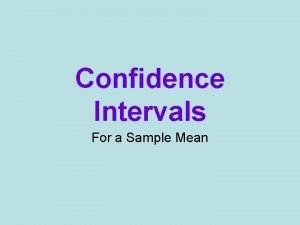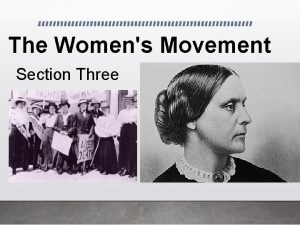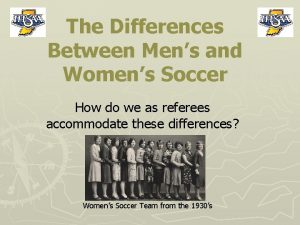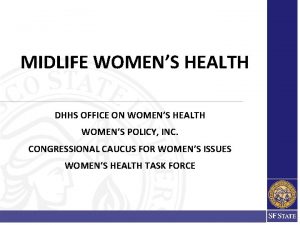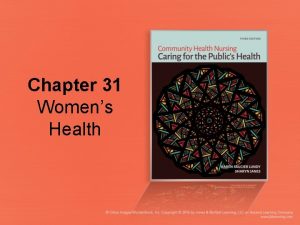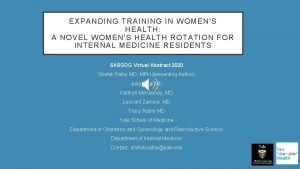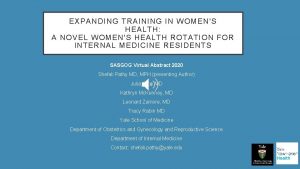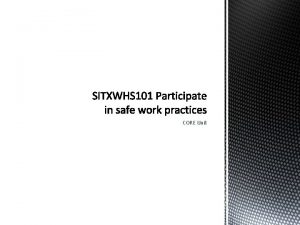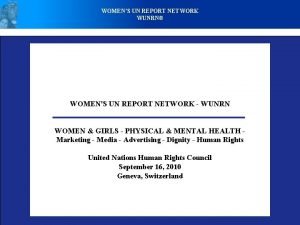Womens Health Study The Womens Health Study WHS






















- Slides: 22

Women’s Health Study • The Women’s Health Study (WHS) is an ongoing, randomized, double-blind, placebo-controlled trial of aspirin and vitamin E in >28, 000 middle-aged women with no history of CHD. • This nested case-control study involved Nuclear Magnetic Resonance (NMR) spectroscopy and standard lipid analysis of baseline serum samples from 130 women who experienced CHD events (MI, stroke, CHD death) during three years of follow-up and 130 controls matched for age and smoking status.


Women’s Health Study Hazard ratios for incident CVD events (n=1, 015) by quintile Q 1 Q 2 Q 3 Q 4 Q 5 LR χ2 LDL-C 1. 0 1. 14 1. 31 1. 55 1. 70 861 Non-HDL-C 1. 0 1. 17 1. 87 2. 00 2. 61 931 Apo. B 1. 0 1. 35 1. 55 1. 76 2. 89 945 LDL-P 1. 0 1. 38 1. 40 1. 96 2. 92 949 Cox regression models were adjusted for age, randomized treatment assignment, smoking status, menopausal status, postmenopausal hormone use, and blood pressure. Likelihood ratio χ 2 statistic evaluates goodness of fit of predictive models. Mora et al. 2007 AHA Scientific Sessions

A prospective comparison of nuclear magnetic resonance lipoprotein profiles in predicting incident diabetes in 26, 911 initially healthy women Samia Mora, James Otvos, Aruna Pradhan, Julie E. Buring, Paul M Ridker Brigham and Women’s Hospital, Boston, MA ACC Meeting, April 1 2008 4

Background: Wilson P and Meigs J, EHJ 2008; 10: B 11 -B 15.

Background 1. LDL cholesterol not a risk factor for type 2 diabetes mellitus (DM 2). Whether other measures of LDL (e. g. LDL particle concentration, LDL subclasses, LDL size) are risk factors for DM 2 is uncertain. 2. HDL cholesterol and triglycerides are risk factors for DM 2. Whether other measures of HDL and VLDL (particle concentration, subclasses, size) are risk factors for DM 2 is uncertain.

Objective To compare NMR-measured lipoprotein profiles with chemically-measured standard lipids in predicting clinical diagnosis of DM 2

Methods: Study Design • Prospective study of apparently healthy women (Women’s Health Study) • N=26, 911 (after excluding baseline DM 2, N=762) • Follow-up: 10. 9 ± 1. 6 y • Main outcome measure: Incident clinical diagnosis of DM 2; N=1, 156

Methods: Lipids/Lipoprotein Measurements Standard Lipids: Direct measurement of: Total cholesterol LDL cholesterol HDL cholesterol Triglycerides NMR Lipoproteins (Lipo. Science, Inc. ): Particle concentrations LDLNMR, HDLNMR, VLDLNMR and their subclasses Average particle size LDLNMR, HDLNMR, VLDLNMR آپآپﻬﻪ

Results Baseline Characteristics Age, y BMI, kg/m 2 Smoking, % HTN, % Postmenopausal, % HRT use, % Incident DM 2 55. 1 31. 4 13. 7 51. 3 No DM 2 54. 6 25. 5 11. 5 22. 9 57. 0 36. 7 53. 9 44. 2

LDL Measures LDL Cholesterol Q 1 Q 2 Q 3 Q 4 Q 5 Ptrend 1. 00 0. 90 1. 01 0. 82 0. 91 0. 22 *Adjusted for age, smk, ASA/VE assignment, menopause, HRT, BP, BMI

LDL Measures LDL Cholesterol Q 1 Q 2 Q 3 Q 4 Q 5 Ptrend 1. 00 0. 90 1. 01 0. 82 0. 91 0. 22 LDLNMR Particle Concentrations (nmol/L) Total LDLNMR 1. 00 1. 12 1. 83 2. 23 3. 15 <0. 001 Small LDLNMR 1. 00 1. 78 3. 19 4. 36 6. 38 <0. 001 Large LDLNMR 3. 41 2. 28 1. 58 1. 60 1. 00 <0. 001 IDLNMR 1. 00 1. 05 1. 27 1. 47 1. 69 <0. 001 *Adjusted for age, smk, ASA/VE assignment, menopause, HRT, BP, BMI

HDL Measures HDL Cholesterol Q 1 Q 2 Q 3 Q 4 Q 5 Ptrend 7. 04 4. 32 2. 39 1. 73 1. 00 <0. 001 *Adjusted for age, smk, ASA/VE assignment, menopause, HRT, BP, BMI

HDL Measures HDL Cholesterol Q 1 Q 2 Q 3 Q 4 Q 5 Ptrend 7. 04 4. 32 2. 39 1. 73 1. 00 <0. 001 HDLNMR Particle Concentrations (nmol/L) Total HDLNMR 1. 54 1. 31 1. 18 1. 15 1. 00 <0. 001 Small HDLNMR 1. 00 1. 23 1. 28 1. 68 1. 76 <0. 001 Medium HDLNMR 1. 00 1. 10 0. 98 0. 30 Large HDLNMR 7. 48 5. 18 3. 47 2. 05 1. 00 <0. 001 *Adjusted for age, smk, ASA/VE assignment, menopause, HRT, BP, BMI

VLDL/Triglyceride Measures Triglycerides Q 1 Q 2 Q 3 Q 4 Q 5 Ptrend 1. 00 1. 45 1. 59 2. 65 4. 12 <0. 001 *Adjusted for age, smk, ASA/VE assignment, menopause, HRT, BP, BMI

VLDL/Triglyceride Measures Triglycerides Q 1 Q 2 Q 3 Q 4 Q 5 Ptrend 1. 00 1. 45 1. 59 2. 65 4. 12 <0. 001 VLDLNMR Particle Concentrations (nmol/L) Total VLDLNMR 1. 00 1. 04 1. 21 1. 07 1. 05 0. 76 Small VLDLNMR 1. 00 1. 23 1. 42 1. 47 1. 32 0. 003 Medium VLDLNMR 1. 36 1. 33 1. 08 0. 99 1. 00 <0. 001 Large VLDLNMR 1. 00 1. 89 2. 99 3. 67 3. 42 <0. 001 *Adjusted for age, smk, ASA/VE assignment, menopause, HRT, BP, BMI

NMR-Measured Particle Size Large Small Q 1 Q 2 Q 3 Q 4 Q 5 Ptrend LDLNMR 7. 18 5. 16 3. 03 2. 16 1. 00 <0. 001 HDLNMR 5. 45 4. 79 3. 23 1. 44 1. 00 <0. 001 VLDLNMR 1. 00 1. 24 2. 03 3. 19 3. 39 <0. 001 Average Particle Size (nanometers) *Adjusted for age, smk, ASA/VE assignment, menopause, HRT, BP, BMI

Conclusions • The relationships of LDLNMR and HDLNMR subclasses as well as LDLNMR, HDLNMR, and VLDLNMR particle sizes with DM 2 remained significant after further adjustment for race, alcohol use, physical activity, family history, HDL cholesterol, triglycerides, hemoglobin A 1 C, CRP



AACC Position Paper Apolipoprotein B and Cardiovascular Disease Risk: A Position Statement From the AACC Lipoprotein and Vascular Disease Division Working Group on Best Practices • Authors: Contois JH, Mc. Connell JP, Sethi AA, Csako G, Devaraj S, Hoefner DM, and Warnick RG • Objective: Position statement on the role of lipoprotein and cardiovascular disease risk.

Key Points • Patient treated to goal for LDL-C may not have achieved correspondingly low LDL particle concentrations, leaving them with potential residual risk. • LDL-P is consistently more predictive of cardiovascular disease than is LDL-C. • Non-HDL-C, like LDL-C, reflects the cholesterol content of atherogenic particles and not the number of atherogenic particles. Importantly, on treatment non-HDL-C concentrations may not reflect residual risk associated with increased LDL particle number. • Both apolipoprotein B (apo B) and low-density lipoprotein particle (LDL-P) concentration should be recognized and included in guidelines, rather than continuing to focus solely on LDL cholesterol (LDL-C).
 Study whs
Study whs Wwusd whs
Wwusd whs Confidence interval assumptions
Confidence interval assumptions Model whs act
Model whs act Swms meaning
Swms meaning Womens ministry activities
Womens ministry activities Womens rights
Womens rights Late night womens hour
Late night womens hour Womens aid aylesbury
Womens aid aylesbury Womens right
Womens right Differences between men's and women's soccer
Differences between men's and women's soccer Womens college kumbakonam
Womens college kumbakonam Womens college kumbakonam
Womens college kumbakonam Womens right
Womens right Womens shelter edmonton
Womens shelter edmonton Womens rights
Womens rights Womens anatomy
Womens anatomy Womens history month door
Womens history month door Womens community shelters
Womens community shelters Ballybeen womens centre
Ballybeen womens centre Scarborough womens centre
Scarborough womens centre Lacrosse helmet mens
Lacrosse helmet mens Bristol womens voice
Bristol womens voice


